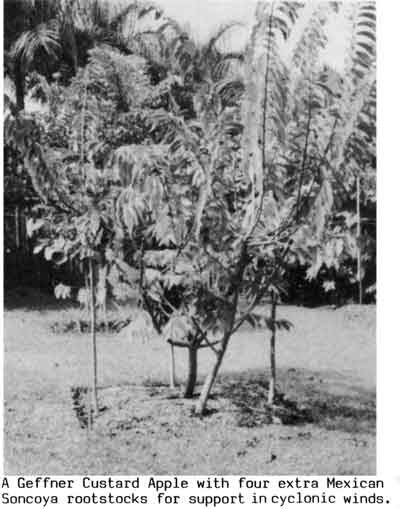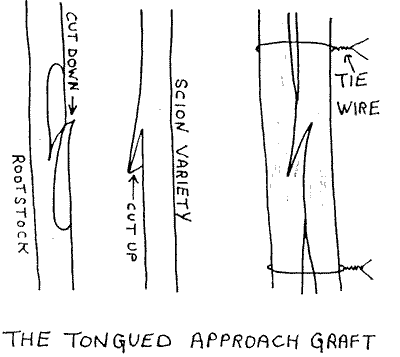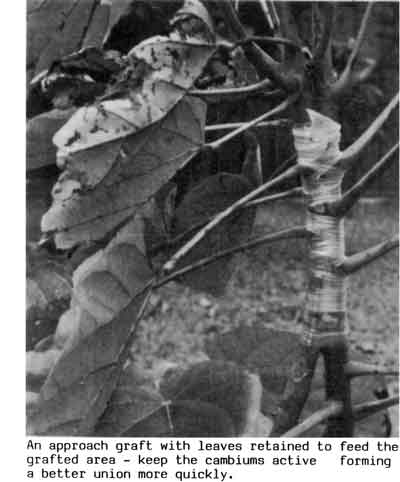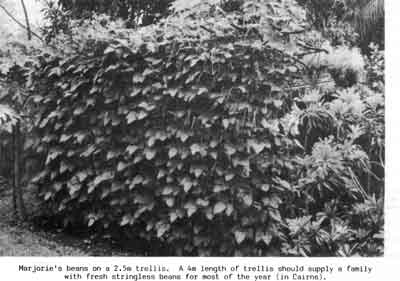
THE BACKYARD GARDEN
An eight-hundred-square-metre garden in Cairns can supply a significant quantity of fruit and vegetables year round. But there are problems to contend with such as cyclones, a long period without sufficient rainfall necessitating frequent irrigation, water restrictions, the sort of bugs you wouldn't read about and in some areas, poor soils.
Having removed seven palm trees, seven bottle brushes, a large gum tree and a Grevillea, two big Fan palms, a non-fruiting seedling mango and a similar lychee, room was made for some fruit trees. In an 800 m2 garden a mango and a lychee would take up too much room eventually and their erratic bearing habits don't make them good subjects for a small garden. And of course they have to be sprayed for pests and diseases more regularly than other fruit trees.

THE CYCLONE PROBLEM
Approach grafting extra rootstocks Torrential rainfall softens the ground making trees susceptible to being blown over in cyclonic weather. In my opinion this necessitates giving fruit trees multiple trunks for better stability, especially with shallow-rooted subjects such as custard apples.
Seedlings of selected rootstocks are planted around the main tree and approach grafted onto its lower branches once they have developed sufficiently. After three or four months the tops of the rootstocks are cut off and the grafting tape removed leaving the tree with two or more root systems for much increased vigour and stability.
Ideally the seedlings should go in at the same time the main tree is planted.
Inarching two varieties together
With limited room in a backyard, it is a good idea to plant two different varieties of the same fruit in the same planting hole 60 or more centimetres apart and inarch a branch of one onto the other as shown in the pictures. This gives stability in cyclone weather and has the added advantage of spreading the harvest if one variety crops after the other.
Inarch twice, one branch lower down and another one higher up. Thus some of my trees have four or more root systems and more than one variety. Nothing is worse than losing a large mature tree in a cyclone and having to start all over again.
Approach grafting in extra rootstocks and inarching two trees together goes some way to making the tree cyclone-proof.
The need to retain side shoots
A word of warning. From experience it would appear to be an advantage to allow side shoots to form on the inarched limb as in the Mamey Sapote picture. This seems to help the limb to thicken up in time thus forming a stronger connection between the two trees.
In the case of the custard apple, for example, when I removed shoots from one of the inarched limbs, it died in subsequent years. Even though it formed a connection between two living trees, the bit in the middle eventually died. On the other hand, connecting limbs with side shoots retained thickened up nicely and became stronger with age.

GRAFTING TECHNIQUE
Interlocking tongues
Whether approach grafting onto additional rootstocks or inarching two trees together, the technIque is the same. But if interlocking tongues are cut as well, downward on the rootstock and upwards on the scion variety, more cambium comes into contact and a much stronger union is formed as in the diagram.
If the wood is thick enough, tongues can be cut. If not, then just bring the two cut surfaces together. Cut surfaces must be of the same width for good matching up of the cambiums. Bind up with 2~cm plastic tape for a good seal. No need to use grafting mastic.
More often than not it is difficult to hold the cut surfaces together and bind up with the tape at the same time. You need four hands. To make it easier, I use short lengths of soft wire as in the diagram. These are removed after taping up.
Leaf retention
Retention of one or more leaves to feed the graft area also helps to rapidly unite the graft for a strong union as in the picture.

GRAFTING MANGOSTEENS
It is said that grafted Mangosteens only grow very slowly. Quite true. This happens when a purple mangosteen scion is cleft grafted onto a purple mangosteen seedling rootstock. The purple mangosteen is a very slow-growing rootstock, so why use it anyway? You want something with guts under the tree to force it to grow more vigorously and come into crop earlier.
Change the rootstock and grafting method and you might get somewhere. Instead, use the yellow mangosteen, Garcinia xanthochymus as the rootstock - as indicated by Popenoe on page 399.
The yellow mangosteen has plenty of vigour; see the tree in the Flecker Botanic Garden in Cairns. It grows like steam.
Instead of isolating the purple from its own rootsystem by cleft grafting, why not plant a purple and a yellow seedling side by side and approach-graft them together once their stems are thick enough. They make a good union, at least they have done in my garden, but they need to be left bound together for about 6 months or even longer as they seem slow to unite. Once a good union has formed, cut the top off the yellow rootstock leaving the purple variety on the two root systems.
I think the shot is to plant out a purple from a nursery, choose a vigorous plant. Raise a few yellow seedlings in pots but only plant out the most vigorous seedling and throw the rest away. Plant the yellow as close as possible to the purple to facilitate approach-grafting later on once their stems are thick enough.
I have two purples approach grafted to a yellow in the middle as in the picture. Now we'll see what happens!
Mangosteens respond well to frequent heavy watering. In fact, I reckon they would grow best actually IN water!
PLANTING HOLE FOR FRUIT TREES
Making the compost
The soil in my garden is sort of like low grade cement! Trees take too long to get established. I get over the problem this way:
I put four-winged blades on the lawn mower. Before mowing the lawn, I spread out kitchen waste, tree and shrub prunings, palm leaves etc. on the lawn and run over them with the mower. It works like a charm. Everything goes in the catcher all nicely cut up and can be used directly as a mulch or heaped up to make compost.
Compost for tree planting takes about 4- 6 weeks to break down enough for use. I turn it once and keep it watered.
Digging the hole
In my ground this takes a lot of sweat. I dig a planting hole 45cm x 45cm x 90cm deep. Increase the hole width if two varieties are planted in the same hole. I loosen the soil at the bottom and put in about 20cm of rough material such as coconut husks and the thick ends of palm leaves etc for drainage.
When the hole is ready, I mix the compost with Dolomite, Blood and Bone, Superphosphate, Sulphate of Potash and trace element mix. The mixed compost is then put in the hole and trampled down firmly after each barrowload. It takes about 3-4 barrowloads to fill the hole.
Good water retention and drainage
After planting the tree in the compost, the hose is left running to thoroughly wet up all the compost and to water in the tree at the same time, also to eliminate all air pockets. Some settling will occur. This leaves a recess for future watering. Generally it takes a few minutes to fill the hole with each watering. Once the hose is turned off, the water disappears very quickly. Even with torrential rain the hole barely fills up. Drainage is rapid because of the large surface area of soil around the sides and base of the hole. There is no clay sub-soil to impede drainage in my garden.
Thus a good reservoir of moisture is retained around the tree roots after each watering and a deep root system is established quickly because of the depth of the hole.
Rapid early growth
Because of the, good compost rooting medium, adequate fertilizer and availability of moisture at all times there is no check to growth even in the hottest and driest weather. Early growth is rapid and thus the tree establishes quickly.
By pruning early for good shape while the tree is growing rapidly primary and secondary limbs can be formed in the first two growing seasons. Thus the tree is well on the way to bearing its first crop.
Get it right before you plant
Early cropping of course will largely depend on the species, whether its a clone or variety of guaranteed performance and grafted on the best rootstock, if applicable. All those sorts of details should be well-established in the first place before even the tree is planted!! Good advice is readily available from the DPI and from within the membership of the RFCA. Ask before you plant.
THE ESPALIERED CARAMBOLA
I have trained my carambola on a six-tiered espalier framework. This makes pruning very easy. Once the main crop is off, all growth is hard pruned back to 8-12 cm spurs from each of which will arise 3-4 shoots. Once fruiting commences all fruit clusters will be bagged against fruit fly. Paper bags are now available from Palmwood Farm and Garden. Just the job, no need for sprays or lures.
THE VENUS TABLE GRAPE
Yes, table grapes can be grown in the tropics. But the trick is to plant the variety that doesn't need spraying for disease control all the time.
The variety VENUS, a hybrid developed in the USA, is sufficiently resistant or tolerant to Downy and Powdery mildews and to Black Spot diseases. My vine is two-years-old and has never shown any disease symptoms so far, and therefore it has never needed spraying. Marvellous.
However, Fruit Spotting Bug attacks the berries while they are still small and green. Don't spray, you'll never keep the bugs off, just bag the fruit bunches soon after setting.
Venus is a black grape with large berries which are seedless and with a slight muscat flavour. The ideal backyard table grape for the tropics in my opinion. Leaves Isabella for dead!

MARJORIE'S BEAN
Southern varieties of climbing bean don't seem to do well in the tropics. Even snake beans don't seem to crop for very long and suffer from collar rot and rust disease in the wet.
But there is a climbing bean that is grown in New Guinea and the islands up North. It can be grown from cuttings as well as from seed. I took cuttings from Marjorie Spear's plants originally. The beans stand out proud of the foliage as can be seen in the picture. They are slightly tougher than ordinary beans and so should be picked when young and tender. They are stringless and are coloured with a slight purple mottling on a green background. The plants seem to last up to a year and crop prolifically all the time as they throw lots of side shoots.
A planting distance of about 60cm apart and trained up bamboo poles spaced 15cm apart seems about right. The leaves and beans are not affected by rust disease or bugs and the plants don't seem to be affected by collar rot. I grow them in small pots first and plant out only the strongest seedlings. Trellis height as far as you can reach.
Editor's Note: be sure to read the sequel to this article, entitled "Rootstocks", September, 1995.
DATE: January 1995
* * * * * * * * * * * * *
